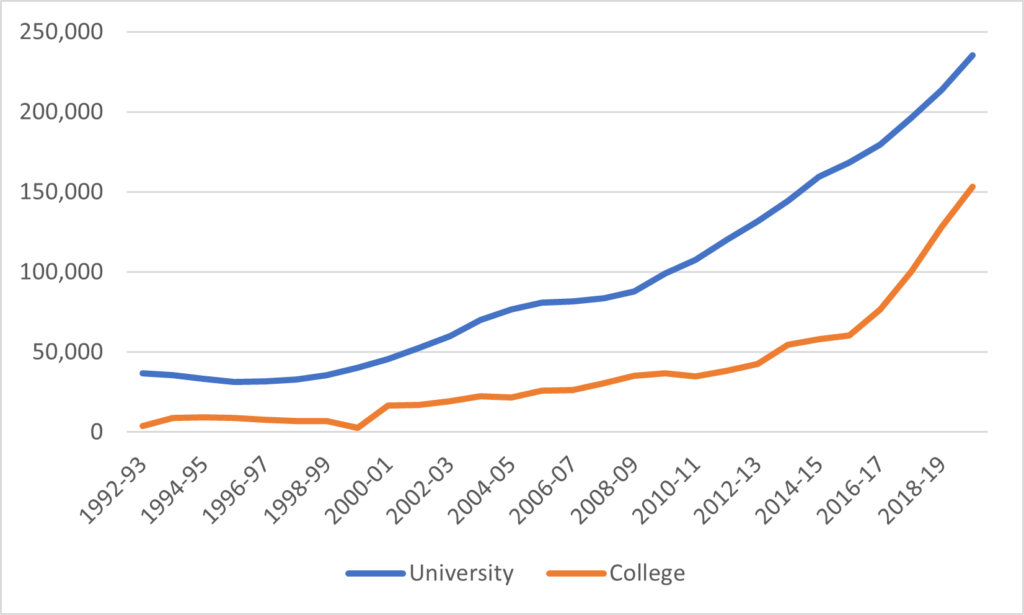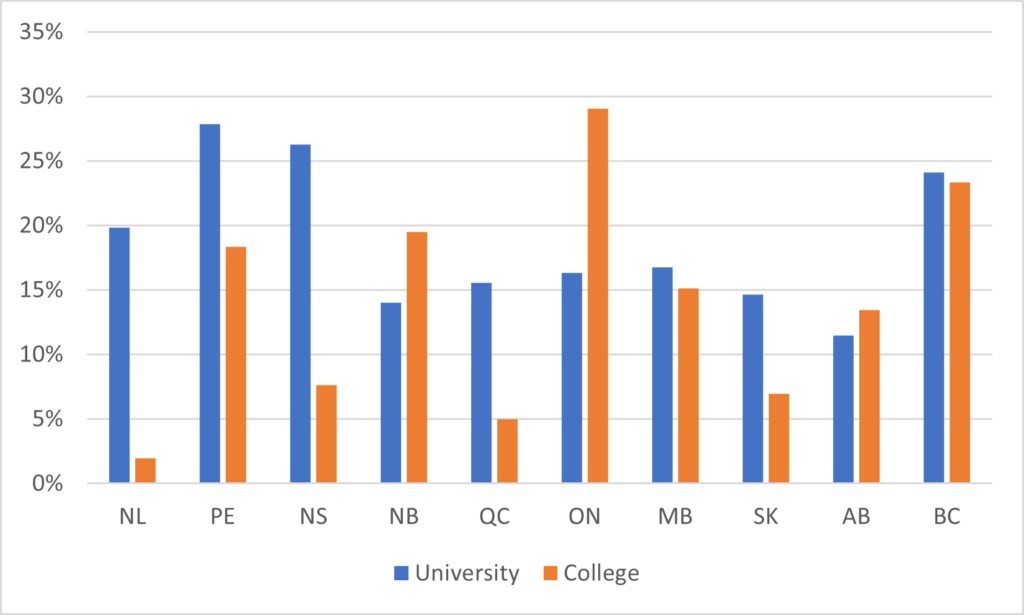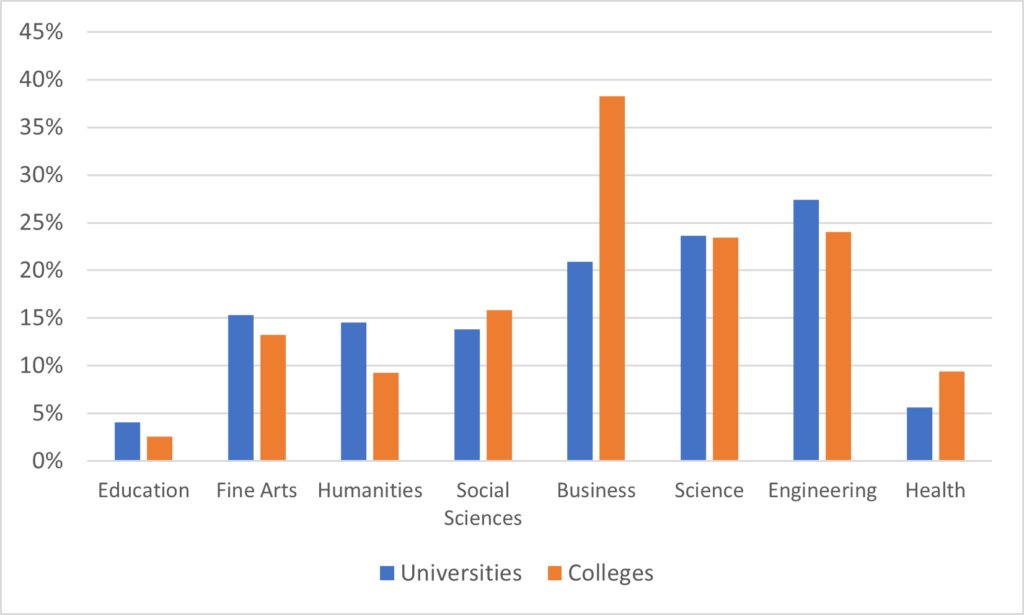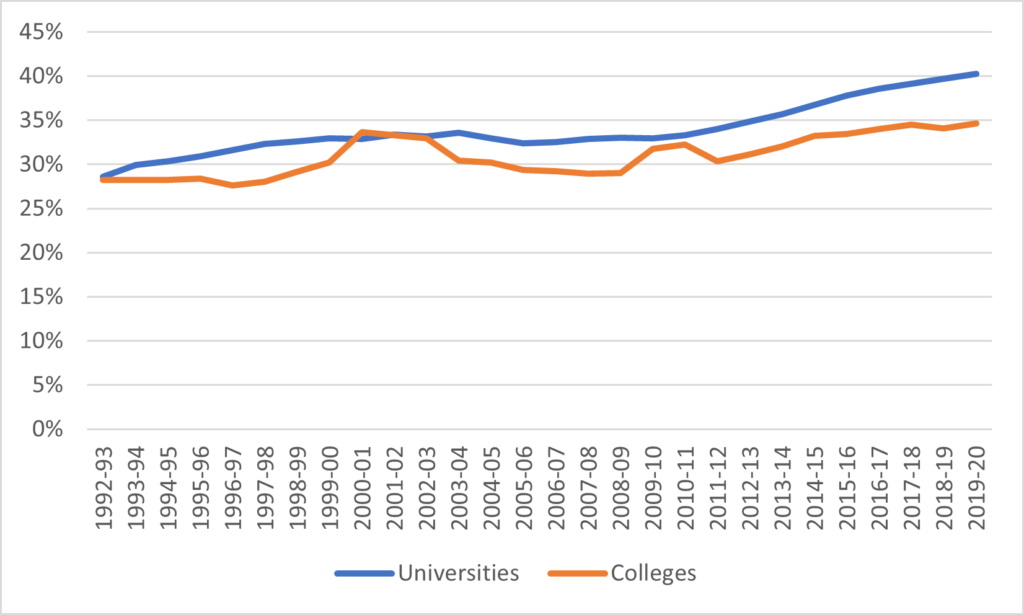Last Wednesday was StatsCan Enrolment Day, 2021. Now, this does not of course mean that we now have data on enrolments for 2021. That won’t happen for another couple of years. No, what it means is that we have data for 2019-20, so we are only about 25 months behind reality instead of the 37 months behind that we were last Tuesday.
(StatsCan is capable of faster work. Heck, it can get university tuition fee increases more or less right at the time they are being paid – though for some reason it can’t figure out how to collect data on college fees at all. It can get data on professorial numbers and salaries in less than 10 months. It can get data on university finances within about 15 months of the end of the fiscal, and college ones with 20 months or so. But student numbers for some reason takes 25 months from the date on the enrolment snapshot. It’s almost as if students are the least important thing about universities from StatsCan’s POV. Curious).
Anyways, let’s plough through the data, shall we? Let’s start with the grimly fascinating international student numbers. Figure 1 shows the total number of international students by sector. The college line is increasingly looking like that climate-change hockey-stick graph Al Gore used to deploy: numbers in that sector have almost tripled since 2013-14 and international students as a percentage of total enrolments have risen to over 20%.
Figure 1: International Students by Sector, 1992-93 to 2018-19

That college line is worth expanding on. Though international student numbers at the college level are up in percentage terms almost everywhere, two-thirds of all these international students are in Ontario, and that’s where the biggest increases have been. In fact, Ontario colleges were approaching 30% international students in 2019-20, which…well, let’s just say that’s quite something.
Figure 2, International Students as a Percentage of the Student Body, Ontario, 1992-93 to 2019-20

Figure 3 shows us that these international students are not distributed equally across the country. The Ontario college sector is now made up of 29% international students. In Newfoundland, the equivalent figure is just 2%. In the university sector the variation is not quite so large; Prince Edward Island is at just under 28%, slightly ahead of Nova Scotia, while Alberta is just 11.5%.
Figure 3: International Students as a Percentage of Student Body, By Sector and Province, Canada, 2019-20

One of the hidden secrets of Canadian post-secondary education is that the country hit peak domestic enrolment in 2012-13. Since then, as Figure 4 shows, domestic university enrolments are down 0.7 percent while in colleges it is down by 7.8%. Only Saskatchewan, Alberta and Ontario have seen growth in domestic university enrolments; Prince Edward Island is the only provinces to have seen domestic enrolment growth on the college side (go, Holland College!). New Brunswick and Newfoundland have seen double-digit declines in both sectors.
Figure 4: Percentage Change in Domestic Enrolment, By Sector and Province, Canada, 2012-13 to 2019-20

Now, it’s possible to look at Figure 4 and Figure 1 and think: “domestic students down, international students up….international students are displacing domestic ones!” But that gets the order wrong – in fact, the disappearance of domestic students, brought on by a demographic bust starting in 2012, which permitted larger international student numbers. The only place where the number of new international students substantially exceeds the drop in domestic students is Ontario, where I think a more sophisticated analysis is needed to ascertain whether any displacement is occurring. Meanwhile, there is also New Brunswick, where the province’s four universities have seen falling domestic enrolment and falling international enrolment since 2012-13 (and it’s not clear how this falling international enrolment is possible.)
What fields do international students study? No real surprise here: the proportions are low in regulated professions (e.g. education, health), and high in business, science and engineering. And given Canada’s long-term anemic growth levels: if the rest of the world is coming to Canada for tips on business, the rest of the world must be in much worse shape than is generally acknowledged.
Figure 5: International Students as a Percentage of Student Body, By Major Field of Study and Sector, 2019-20

Speaking of fields of study, last week’s numbers continue to demonstrate the ongoing shift towards science-based fields in Canadian post-secondary education. If one combines the STEM fields with the health fields, as done below in Figure 6, then we see over 40% of university students are enrolled in these sectors, along with 35% of college students,both up substantially over a decade ago.
Figure 6: Percentage of Total Enrolments in STEM + Health, By Sector, Canada, 1992-93 to 2018-19

Finally, to the perennial question of what is going on with humanities enrolments. Well, it’s a bit hard to say exactly because StatsCan seems to have done some kind of wholesale revision of its data for the past 20 years and has reduced its estimates of the number of students in humanities for pretty much all of the past 20 years (I assume they have transferred some sub-fields of study to other domains, but can’t tell for sure). In any case, data suggests that the fall in humanities enrolments has been even steeper than first thought: down 28%, while everyone else, bar education, is seeing pretty big increases. Another interesting point here is how business enrolments seem to have plateaued lately while enrolments in science continue to climb; my guess is, given the changes in student preferences we’ve been seeing in the pandemic, science may have already become the #1 field for enrolment (though, you know, it’ll take 2 more years to find out because StatsCan).
Figure 7: Enrolments by Major Field of Study, Canadian Universities, 1992-93 to 2019-20


 Tweet this post
Tweet this post

A quick comment – While StatsCan does not collect college tuitions, the government of BC does every year, and shares it back with all the provinces. BC has been doing this for many years now.